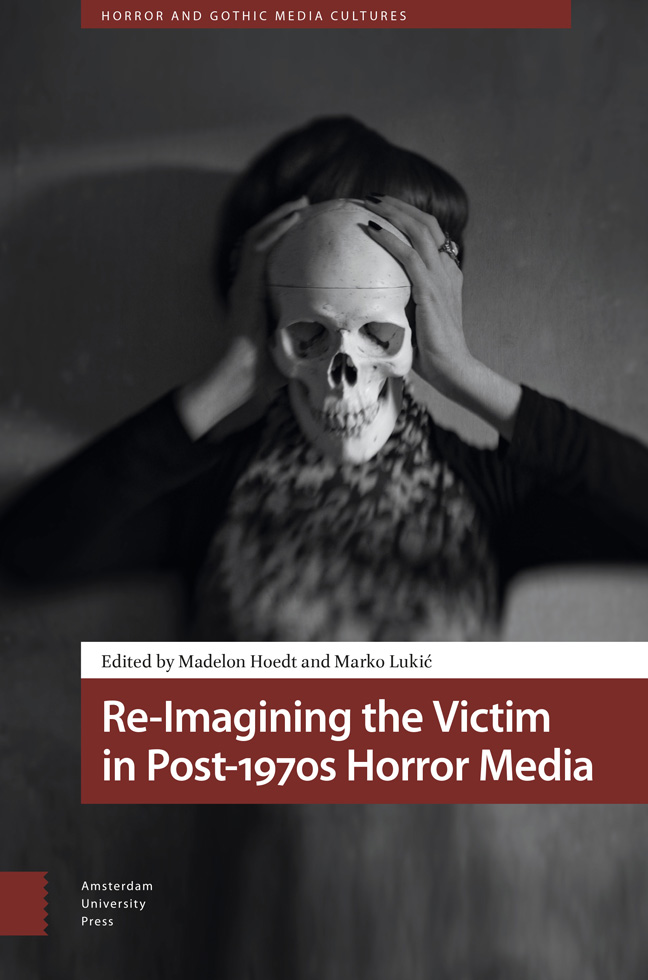Book contents
- Frontmatter
- Contents
- Introduction: Theorising the Victim
- 1 Opening the Gate: Reconfiguring the Child Victim in Stranger Things
- 2 Black Death: Black Victims in 1980s Teen Slashers
- 3 Beyond Binaries: The Position of the Transgender Victim in Horror Narratives
- 4 Through the Looking-Glass: The Gothic Victim in Jordan Peele’s Us
- 5 Postmortem Victimhood: Necrovalue in Phantasm and Dead and Buried
- 6 The Sad Killer: Perpetuating Spaces, Trauma and Violencewithin the Slasher Genre
- 7 “If this is the last thing you see… that means I died”: A Taxonomy of Camera-Operating Victims in Found Footage Horror Films
- 8 Victimhood and Rhetorical Dialectics within Clive Barker’s Faustian Fiction
- 9 Pain Index, Plain Suffering and Blood Measure: A Victimology of Driving Safety Films, 1955–1975
- 10 Biolithic Horror: Stone Victim/Victimisers in Resident Evil Village
- 11 The Potential Victim: Horror Role-Playing Games and the Cruelty of Things
- Bibliography
- Filmography
- Index
Introduction: Theorising the Victim
Published online by Cambridge University Press: 26 March 2024
- Frontmatter
- Contents
- Introduction: Theorising the Victim
- 1 Opening the Gate: Reconfiguring the Child Victim in Stranger Things
- 2 Black Death: Black Victims in 1980s Teen Slashers
- 3 Beyond Binaries: The Position of the Transgender Victim in Horror Narratives
- 4 Through the Looking-Glass: The Gothic Victim in Jordan Peele’s Us
- 5 Postmortem Victimhood: Necrovalue in Phantasm and Dead and Buried
- 6 The Sad Killer: Perpetuating Spaces, Trauma and Violencewithin the Slasher Genre
- 7 “If this is the last thing you see… that means I died”: A Taxonomy of Camera-Operating Victims in Found Footage Horror Films
- 8 Victimhood and Rhetorical Dialectics within Clive Barker’s Faustian Fiction
- 9 Pain Index, Plain Suffering and Blood Measure: A Victimology of Driving Safety Films, 1955–1975
- 10 Biolithic Horror: Stone Victim/Victimisers in Resident Evil Village
- 11 The Potential Victim: Horror Role-Playing Games and the Cruelty of Things
- Bibliography
- Filmography
- Index
Summary
“Be my victim…” (Candyman, Rose, 1992)
It is with these words that the mythical figure of Daniel Robitaille, better known as Candyman, beckons Helen Lyle to submit herself to him and to accept him as her killer. While this particular moment will become an anthological point of reference within the horror genre due to the sheer power of the conveyed image, further strengthened by the metaphoric cultural and social meanings imbued within it, what strikes a particular chord is the established and emphasised relation between the two characters. This mythopoetic moment becomes synonymous with both the (re) affirmation of Candyman as the source of the monstrous, the urban myth come to life, and the particular position of Helen as an (in)voluntary victim. As the narrative steadily progresses and the audience becomes aware of Candyman’s tragic history and vengeful nature, the focus slowly starts to shift from the initial antagonist to Helen, who now, through Candyman’s doings, becomes reimagined as the actual source of the monstrous. This shift in purpose and functionality within the narrative becomes once more confirmed in a climactic scene at the very end of the film, with Helen becoming/ replacing Candyman himself, but now, devoid of the burden of Daniel Robitaille’s tragic history, rises as a violent urban myth in her own right. This is a key moment, along with many examples in recent decades, where the initial premise of the victim is challenged as a possibly fluid category and it becomes evident that the position of the victim is not a powerless one, as explored, for example, in the seminal work done by Barbara Creed (The Monstrous-Feminine, 1993, and The Return of the Monstrous-Feminine, 2022) or Carol J. Clover (Men, Women, and Chain Saws: Gender in the Modern Horror Film, 1992).
While both authors position their work within theoretical readings of gender and sexuality, with particular attention towards women as the most common victims within the genre, they also articulate two rather different theoretical paradigms. Whereas Barbara Creed observes women being “represented as monstrous” (Monstrous-Feminine 7) and subsequently argues that the now monstrous-feminine functions as a subversion of patriarchal power and the symbolic order, Carol J. Clover, through her concept of the Final Girl, argues the absence of a clear gender binary with the Final Girls/ victims being in fact “boyish” (Men 40).
- Type
- Chapter
- Information
- Re-Imagining the Victim in Post-1970s Horror Media , pp. 7 - 18Publisher: Amsterdam University PressPrint publication year: 2024



